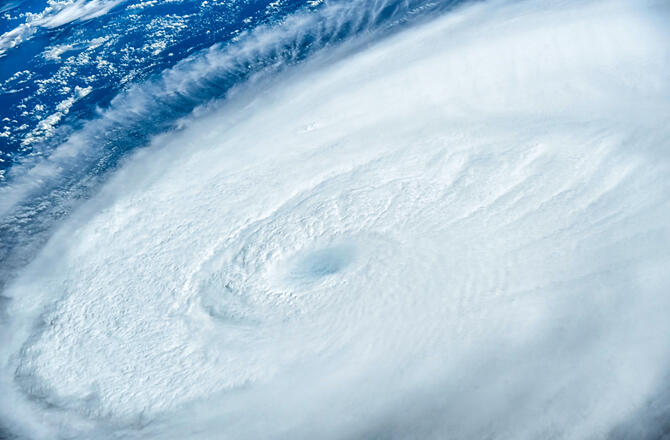Using two Wave Gliders (autonomous unmanned observation vehicles), NTT and the Okinawa Institute of Science and Technology (OIST) have achieved the world's first simultaneous observation of the atmosphere and ocean at multiple locations during a pre-landfall Category 5 typhoon (the strongest class) in the North-West Pacific Ocean.
This accomplishment was achieved during observations directly beneath Typhoon No. 11 (Hinnamnor) in the summer of 2022. Through joint research, both parties aim to establish observation methods that contribute to improved typhoon prediction accuracy and to elucidate the mechanisms of interaction between the atmosphere and ocean using observation data obtained directly beneath typhoons.

Disasters caused by typhoons have become increasingly severe owing to climate change, including global warming. To prepare for these disasters promptly, accurate assessments of the state of typhoons developing at sea are necessary before they make landfall.
Currently, however, the intensity of typhoons over the ocean and the storm information in weather forecasts are based on estimates obtained through satellite image analysis, and other means, which pose a challenge to prediction accuracy. Direct aircraft-based observations are being conducted as part of a national research project to improve typhoon forecasting accuracy. The contribution of aircraft-based observation data to enhancing the accuracy of typhoon information has been verified.
In 2013, OIST successfully conducted simultaneous atmospheric and marine observations directly under the very strong Category 4 Typhoon No.24 (Danas) using a Wave Glider (model number SV2, named 'OISTER'), an autonomous unmanned surface vehicle from Liquid Robotics, Inc.
Through such research, it became apparent that the conditions near the ocean's surface directly beneath a typhoon needed to be better understood. However, owing to the harsh environmental conditions, particularly in the case of strong typhoons, sufficient observations have not been conducted so far.
Given these circumstances, NTT and OIST initiated their joint research in 2021 with the aim of achieving observations that will provide essential information for typhoon prediction, even in harsh storm environments. In 2022, NTT introduced a new Wave Glider (model SV3, named 'Seiuchi-san') and used it together with 'OISTER' to conduct typhoon observations.
Typhoon Hinnamnor, which occurred near the island of Minamitorishima on August 28, 2022, intensified with a minimum central pressure of 920 hPa while moving westward, becoming a violent Category 5 typhoon. After checking the predicted path of the typhoon, observations were conducted using the two Wave Gliders. 'Seiuchi-san' observed the violent wind region (average wind speeds of 25 meters per second or higher) located approximately 11 kilometers from the center of the typhoon, while 'OISTER' conducted simultaneous observations of the atmosphere and ocean in the strong wind region (average wind speeds of 15 meters per second or higher) spanning approximately 100 kilometers.
As a result, with regard to the air pressure directly related to the typhoon's intensity, 'Seiuchi-san' captured the rapid changes in pressure within the violent wind region and confirmed that the minimum pressure value occurred at approximately 22:00 on August 31, when the typhoon was closest to land. By contrast, no significant decrease in air pressure was observed by 'OISTER,' even though it was conducting observations in the strong wind region.
Furthermore, during this observation, both Wave Gliders successfully captured the changes in seawater temperature, which is crucial information for predicting the intensity of typhoons. The variations in seawater temperature affect the energy supply to the typhoon and are correlated with its intensity, making them an essential factor for the accurate prediction of the storm's intensity. At its location near the center of the typhoon, 'Seiuchi-san' measured a more rapid decrease in seawater temperature (about 2 degrees Celcius).
Additionally, 'Seiuchi-san' was able to observe waves of up to 9 meters in height. The ability to obtain information on waves that form directly beneath typhoons, which is not easily accessible through conventional satellite observations, is an invaluable feat.
These results were published in the Volume 19 (2023) of the Scientific Online Letters on the Atmosphere (SOLA), an international journal published by the Meteorological Society of Japan.
Both NTT and OIST aim to improve the accuracy of typhoon prediction by establishing better typhoon observation methods and improving typhoon prediction models through a better understanding of typhoon mechanisms. They seek to realize more precise predictive analyses for pre-landfall typhoons. Additionally, in the future, they plan to optimize methods for real-time typhoon observation through collaboration with various industries and institutions and to apply such techniques to super-wide-ranging atmospheric and marine observations using Space integrated computing network.
Journal Information
Publication: Scientific Online Letters on the Atmosphere (SOLA)
Title: Simultaneous Observations of Atmosphere and Ocean Directly under Typhoons Using Autonomous Surface Vehicles
DOI: 10.2151/sola.2023-016
This article has been translated by JST with permission from The Science News Ltd. (https://sci-news.co.jp/). Unauthorized reproduction of the article and photographs is prohibited.




